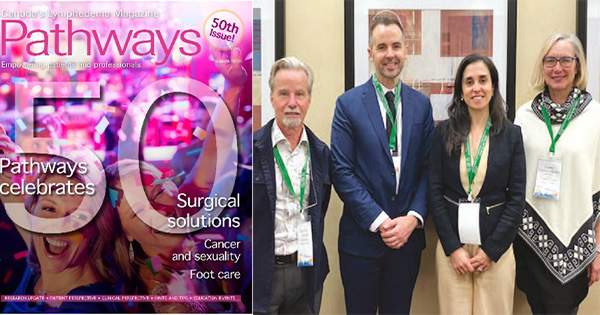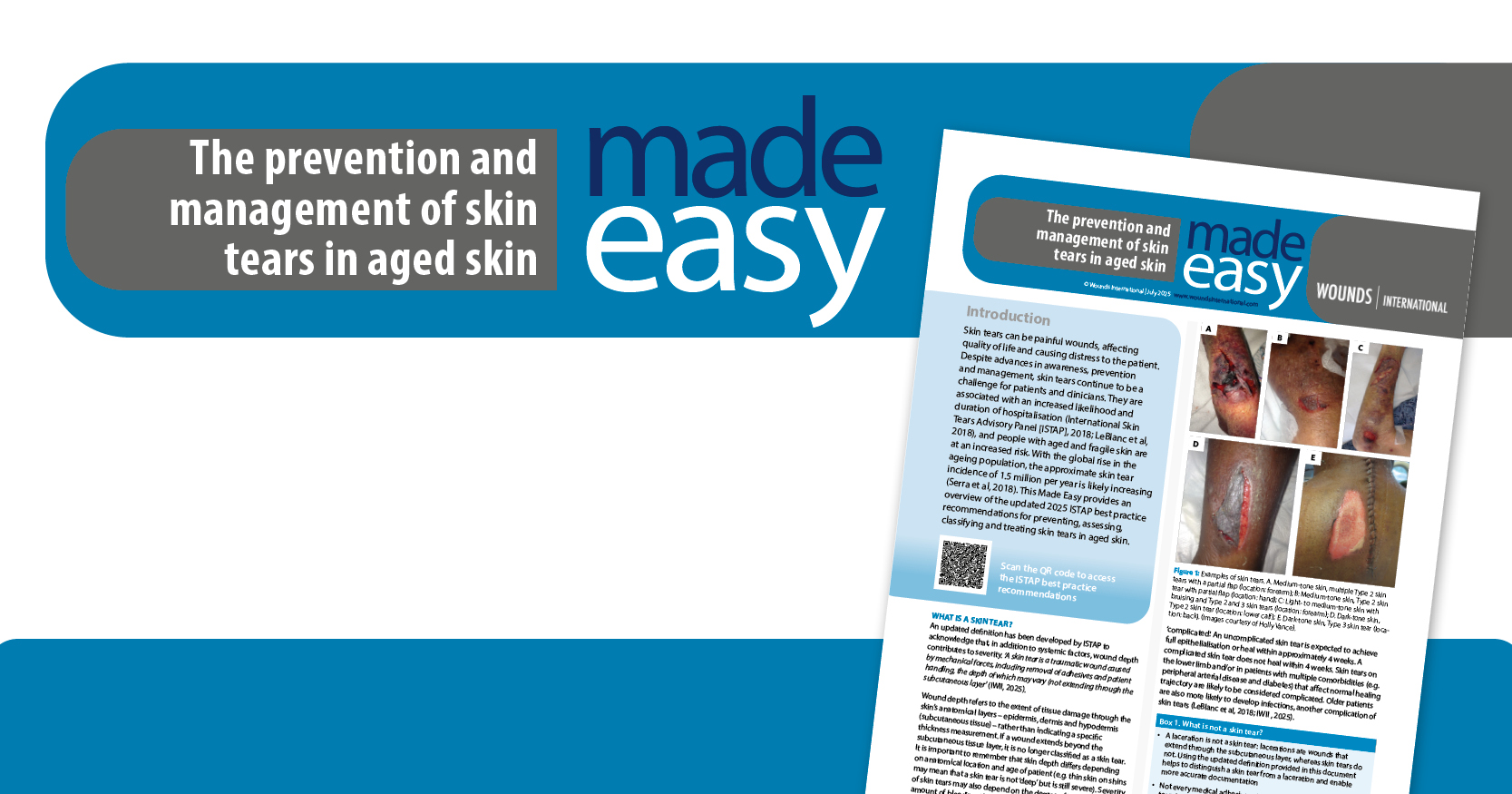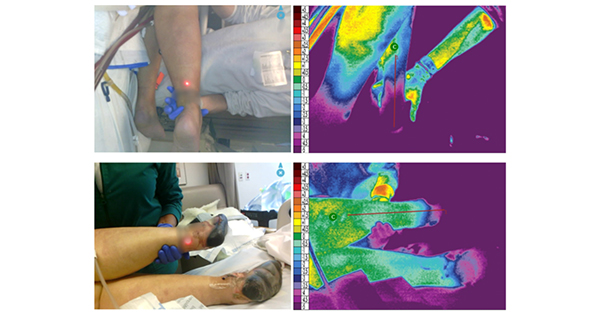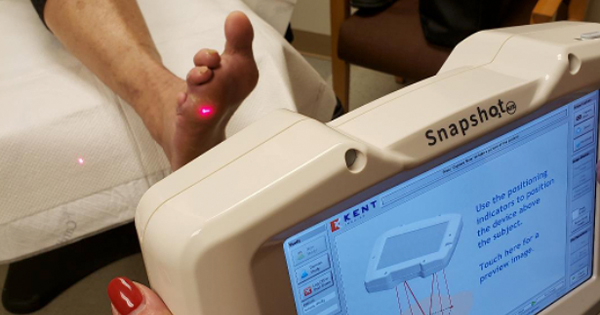As we mark the 15th anniversary of the 2009 inception of the Canadian Lymphedema Framework (CLF),
I am filled with immense pride and gratitude. Over the past decade and a half, we have grown from a fledgling organisation to a formidable force in the field of lymphoedema education, research and advocacy. This milestone serves as a testament to the dedication of our board of directors, the efforts of our founders, past directors and staff, the support of our partners.
Our current board of directors is a diverse group of passionate individuals who bring a wealth of expertise and a shared commitment to our mission. The board’s leadership and vision have been instrumental in steering the CLF towards new horizons and I am profoundly grateful for their service.
They are: chair and treasurer David Keast, Msc Dip Ed MD CCFP FCFP(LM, vice-chair Siba Haykal, MD, PhD, FRCS(C), FACS, past co-chair Catherine McCuaig, MD, FRCPC, director Spencer Gibson, PhD, director Maryse Beaumier, BNSc, MSc, PhD and director Naomi Dolgo, M.OT, CLT, PhD.
We owe a debt of gratitude to our founders and past directors. Their vision and efforts laid the groundwork for our current successes. Their pioneering spirit and relentless pursuit of excellence have been the bedrock upon which we have built our current initiatives. These contributions have created a lasting impact that continues to inspire.
A pathway of achievement
The CLF has achieved many milestones that have contributed to advances in the field of lymphoedema:
- Education initiatives: We have developed comprehensive educational resources which have empowered healthcare professionals and patients with essential knowledge and skills. These include the University of Alberta Lymphedema and Chronic Edema Management microcourse, our web-based and print educational materials and our Lymphedema Learning Library Online.
- Pathways: We are incredibly proud of our Pathways magazine and grateful to our editor Anna Kennedy and her editorial board members, past and present, for their passion and hard work to produce this quarterly magazine, which recently celebrated 50 issues. The history of Pathways is discussed later in this piece.
- Research and clinical advancements: Our participation in international studies such as LIMPRINT (Lymphoedema IMpact and PRevalence – INTernational Lymphoedema Framework; ILF) has contributed valuable data on the prevalence and impact of lymphoedema, helping to shape the future of treatment and care in Canada.
- Biennial, national conferences: Our conferences bring the lymphoedema community together to network and learn and aim to inspire new research and collaboration to improve the lives of those living with lymphoedema.
- Advocacy and awareness: through initiatives such as World Lymphedema Day and March Lymphedema Awareness Month, we have raised the profile of lymphoedema, advocating for better recognition, diagnosis and treatment.
- Collaborative partnerships: Our partnerships with provincial and international lymphoedema organisations and other stakeholders have been pivotal in advancing our mission and expanding our reach.
These achievements are a collective victory, made possible by the unwavering support and collaboration of our stakeholders.
We invite you to learn more about our work by reading our 2023–24 Impact Report, which can be found on our website, canadalymph.ca.
Reaffirming our vision and mission
The CLF remains steadfast in its dedication to our vision and mission. Our vision: that comprehensive treatment for lymphoedema and related disorders will be accessible to all persons across Canada. Our mission: to improve the management of lymphoedema and related disorders in Canada through collaboration, innovation and evidence-based practices.
We continue to strive for a future where lymphoedema is universally recognised, effectively treated and no longer a silent burden.
Gratitude to our supporters
None of our accomplishments would be
possible without the generous support of our readers, volunteers, sponsors, advertisers, exhibitors and partner organisations. Your contributions, whether through financial support, advocacy, or collaboration, have been the lifeblood of our organisation. We are deeply grateful for your unwavering support and commitment to our purpose.
Looking ahead: co-hosting the International Lymphoedema Conference in Canada in 2025
As we celebrate our past achievements, we also look forward to the future with excitement and anticipation. The CLF is incredibly proud to co-host the 2025 International Lymphoedema Conference in Niagara Falls, Canada, in October 2025. This event promises to be a landmark gathering of experts, practitioners, patients and advocates from around the world, fostering knowledge exchange and collaboration on a global scale.
We invite you to join us at this prestigious event, to share in the latest advancements in lymphoedema research and treatment and to contribute to the ongoing dialogue that shapes our field. We share an overview of our last national conference in 2023 later in this article.
Inspiring future leaders
We invite passionate and dedicated individuals to consider joining us to contribute to our mission. Whether as a conference attendee, a contributor to Pathways magazine, a volunteer supporting our special projects and events, or by joining our staff or board of directors, your unique perspective and expertise can help drive forward our initiatives and ensure the continued success of the CLF.
The 15th anniversary of the CLF is not just a celebration of our past but a beacon lighting the way forward. Together we have achieved remarkable things and together we will continue to make a difference in the lives of those affected by lymphoedema. By reflecting on our achievements and setting our sights on future goals, we reaffirm our commitment to the lymphoedema community and continue to strive for a brighter, healthier future for all. Thank you for being part of this journey. Here’s to many more years of progress, innovation and impact.
Bonnie Baker, executive director, CLF
50 issues of Pathways magazine
Pathways is the official publication of the CLF. Canada’s only lymphoedema magazine addresses the need for lymphoedema awareness and education among patients, those at risk and healthcare professionals.
How Pathways started
It was 2011, only 2 years after the founding of the CLF, when a strategy session highlighted the need for a vehicle to provide a united voice for patients and clinicians in Canada. Education was a key priority and what better way to promote education than through a national lymphoedema magazine?
Our direction
From the start, we were focussed on separating Pathways from publications that were already available within the lymphoedema community. On the one hand, we did not want to compete with peer-reviewed journals targeted at therapists and clinicians. On the other hand, we wanted to be positioned differently than a newsletter focused solely on the patient community. We determined our niche was to provide a unique educational platform for those living with lymphoedema and the professionals supporting their care.
A plan was born
Several collaborative meetings were held with provincial lymphoedema association representatives and CLF board directors, and staff. The inaugural issue of Pathways was launched in spring 2012 with an initial goal of publishing three issues per year. However, as positive feedback poured in quickly from readers, advertisers, and sponsors, we immediately expanded the publication to be a quarterly magazine.
Our funding
l Advertising and sponsorship: We garnered strong support from industry sponsors and advertisers from the start. Companies making, selling or distributing goods and services to support the lymphoedema community see the marketing opportunities that a widely distributed lymphoedema-focussed magazine offers. We thank them for their financial support and the message of hope they provide to patients by offering innovative products and services for lymphoedema management.
l Grant funding: The Canadian federal government, through the Canadian Periodical Fund, provides assistance to eligible magazines that promote Canadian content. We have been fortunate to have received the Aid to Publishers grant for the past three years. This aid supports expenses related to the magazine’s production and promotion.
l Subscriptions: Our readers can choose to subscribe directly through the CLF or through their local provincial lymphoedema association. The provinces pay a reduced fee to purchase bulk copies of Pathways for distribution to their members as a benefit of membership.
Distribution
Ideally, we would love to be able to distribute the magazine freely to anyone who wants to learn about lymphoedema. Unfortunately, as a small charity, we do not have enough funds. However, we recognise that the magazine is passed along from reader to reader and reaches many people who are not paid subscribers.
Our audience
Pathways is targeted at both patients and those at risk, their caregivers and the communities that support them. It is also uniquely focussed on the professionals who support their care. These are physicians, nurses, therapists, community care workers, lymphoedema educators, health policy makers and retail distributors. We reach our audience in hospitals, universities, cancer institutions, breast cancer centres, lymphoedema treatment centres, libraries and at national and international conferences. Pathways has become popular, not only within Canada and the US, but also has subscribers in Europe, Australia, South Korea and the UK. We have digital readers in 50 countries.
Top contributors
Contributors to Pathways include an impressive collection of dedicated opinion experts in the field of lymphoedema who help advance topics that address the critical issue of lymphoedema care. Over the years we have been very fortunate to have prestigious authors from Canada, US, Europe, Australia and India contribute. We use our connections and network to bring these experts to our readers. Two of our most frequent requested reprints are for Lori Radke’s Top 10 Self-care Tips (summer 2015) and Practical Exercise Tips from Marize Ibrahim and Helen Yang.
Favourite stories
Someone asked me recently what my favourite Pathways stories or articles have been. It is certainly difficult to choose, but one in particular does stands out. The summer 2014 issue highlighted the holistic protocol for lymphoedema care being provided by the Institute of Dermatology (IAD) in India. This article demonstrated to our readers how Pathways provides a window into what is happening in other parts of the world and helps us appreciate what we have access to in North America.
I love it when we receive letters to the editor that challenge an article we featured. This is a good indication that people are willing to question, delve into and investigate, all in the interest of what is best for the lymphoedema patient. I am glad that Pathways is a vehicle that can facilitate healthy discussions within our community. Certainly some of my favourite magazine covers feature real people proudly showing how they live with lymphoedema. From the adorable child Ben Nedjelski to actress Kathy Bates, the personal perspectives we feature emphasises how lymphoedema can affect anyone: men, women and children, famous or not.
The production schedule
It takes a village to publish this quarterly magazine. Authors submit or are invited to write an article on a particular topic suggested by the editorial board and editor. Contributor guidelines require a minimum of three recent references to ensure the material is evidence-based, current and relevant to our readers. Editorial board members review all submissions for fact-checking, accuracy and suggest edits for any required revisions. We are fortunate to have some of the best lymphoedema experts in Canada and the US on our board. They meet with our editor four times per year to provide direction, editing support and suggest topics and authors. The editor liaises with the authors, collates all the submissions and performs final editing before making decisions on what goes into each issue, before developing a flowchart to indicate the sequence and layout of the articles and advertisements.
BCS Publishing creates the graphic design layout, adding visuals, photographs and illustrations. They are responsible for the creative magazine covers as well. We have been fortunate for continuity with the same great company and graphic artist working hand-in-hand with us throughout these years. They also take care of logistics including printing, shipping and mailing.
CLF’s executive director (ED) manages all the relationships with industry for sponsorships and advertising. Responsibilities for the day-to-day operations regarding subscriptions, invoicing, mailing lists, digitising the magazine for the website and promoting via social media are all done by the ED and marketing manager. I am personally proud of this magazine. It provides a high-quality view of what is currently happening in the world of lymphoedema, as well as a view towards exceptional things that are yet to come.
Editorial board members
None of this would be possible without our dedicated editorial board, past and present. They graciously lend their time and expertise and play an important role in the education of lymphoedema. Thanks to current board members Dr Anna Towers, Dr David Keast, Professor Mei Fu and Lori Radke. I encourage you to read their biographies and contributions on the CLF website at canadalymph.ca.
Here is what our supporters say…
Prof Neil Piller, Flinders University, Australia: “Lymphoedema and its linked conditions ideally require holistic continuous care involving a team of linked professionals. That is what Pathways has always facilitated and promoted through its information-sharing with a great balance between patient views and needs, health professional and research advice and best practice guides and just as importantly showing all about what industry has to offer to gain the best outcomes for all.”
Dr Tobias Bertsch, Földi Clinic European Center of Lymphology: “Pathways is a remarkable magazine. It provides valuable and helpful information for very different groups: for patients, for those interested in science, for physiotherapists and for doctors. Pathways is also a very popular source of information at the Földiklinik in Germany, the European Centre for Lymphology. Congratulations on the 50th issue.”
Prof Christine Moffatt, chair, ILF: “It is my great pleasure to congratulate the CLF on celebrating 50 editions of the Pathways publication. This fantastic resource reaches all parts of the globe and is highly valued by patients, clinicians, academics and healthcare providers. Not only is it relevant to readers but it also provides rigorous advice that can really be trusted. I look forward to seeing the next 50 editions and seeing the work of the CLF go from strength to strength.”
Thank you
So, with the tremendous milestone of 50 issues, I personally want to thank our sponsors, advertisers, authors, editorial board members and CLF staff who all make this happen. Finally, thanks to all our readers. You continue to inspire us and motivate us to plan enthusiastically for the next 50 issues.
Anna Kennedy, editor, Pathways
The 2023 National Lymphedema Conference was another success
The CLF hosted its 2023 National Lymphedema Conference in Toronto on 3–4 November 2023. There were more than 300 attendees, including patients, caregivers, therapists, nurses, physicians, surgeons, compression fitters and exhibitors. The following review highlights the plenary sessions and some of the breakout sessions.
Why weight?
Denise Campbell-Scherer (Alberta) kicked off the conference with a keynote address on “What you need to know about the Canadian Adult Obesity Clinical Practice Guidelines”. Our knowledge of obesity has progressed with an increased recognition of the roles of the gut microbiome, genetics, mood (stress), and sleep on obesity.
The new 2020 Obesity Canada Guidelines focus on patient-centred care and improvement of health and wellbeing. Tools such as the Edmonton Obesity Staging System and the 5As of Obesity Management can help guide obesity assessment and support. The focus should be on the best weight for a person rather than the ideal weight. A key takeaway from this session on managing health and weight is: “Never start a treatment or change in behaviour that you can’t continue forever”. Sustainability is key.
Prospective surveillance
There is increasing research evidence supporting the benefits of prospective surveillance for cancer-related lymphoedema screening. Shirin Shallwani (Ontario) outlined the main components: baseline assessment and routine monitoring, education and risk-reduction (exercise, skin care, weight management), early detection of lymphoedema (subclinical/early stage) and individualised management.
Challenges to implementing a prospective surveillance programme include limited resources (time, equipment, trained professionals) and non-standardised procedures for diagnosis and management of subclinical/early lymphoedema. Possible solutions include identifying and prioritising individuals at high risk of lymphoedema, integrating patient management (e.g. self-measurement) and incorporating technology (e.g. electronic patient-reported outcomes).
Body image and sexuality
Cancer may impact all aspects of sexuality and even more if lymphoedema is present. Marie-Eve Letellier, Sandra Rotholc and Anna Towers (Quebec) led participants through this important topic, often considered taboo for discussion between patients and healthcare professionals. However, communication is fundamental and must occur between patients and their partners, doctor, and healthcare professionals. Wellbeing, quality of life, and fulfilment are essential for all patients with lymphoedema.
Foot care
Lymphoedema in the lower limb causes skin and health changes. Maryse Beaumier (Quebec) and Audrey Wall (Ontario) provided practical foot-care tips for patients and healthcare professionals. Drink lots of water, perform daily inspections, practice meticulous hygiene, wear well-fitted footwear and seek professional help from a foot-care nurse, a podiatrist, or a chiropodist as part of your lymphoedema management.
Relationship-centred care
“Moving Patients to Make Meaningful and Sustainable Health Behaviour Changes with Relationship-Centred Care” was Saturday’s keynote address by Celine Koryzma (Alberta). Lymphoedema management is difficult, and making changes in health behaviour is challenging. One important factor that can lead to sustained behavioural change in patients is having a supportive relationship with healthcare professionals. Relationship-centred care means clinicians move from an expert role to a collaborator role. Communication can be facilitated through practicing non-judgemental curiosity and incorporating motivational interviewing techniques. Other strategies include linking health behaviour goals to personally meaningful values, supporting self-efficacy and promoting habit change.
Surgery
Siba Haykal (Ontario) moderated a panel discussion on the “Surgical Management of Lymphedema”. Determining the appropriate surgical technique depends on lymphoedema staging and ICG imaging, which can show which elements of the lymphatic system are still working.
Panellist Claire Temple-Oberle’s (Alberta) presentation described the primary prevention of lymphoedema in melanoma and the clinical trial data on avoiding lymphoedema by de-escalating surgery in the nodal basin. In secondary prevention of lymphedema in melanoma, several clinical trials are underway for immediate lymphatic reconstruction to prevent lymphoedema in patients requiring lymph node dissection. This prophylactic surgery involves re-establishing lymphatic circulation after ilioinguinal or axillary lymphadenectomy. Patient-reported outcomes using the Lymphoedema Quality of Life Tool were relatively high.
Benoit Cartier (Quebec) led us through two types of lymphatic surgeries.
- Lymphovenous anastomosis, lymphatic grafting and lymph node transplants are lymphatic reconstructive options classified under physiological interventions.
- Excisional lymphoedema surgeries are appropriate for a very small portion of the population who are at the late stage of the disease and have failed all conservative treatment methods.
- Although surgical interventions have been around for many years (the first microsurgery was performed in 1960), advanced technology, including high-powered microscopes, near-infrared imaging and precision instruments, has enabled procedures that involve tiny lymphatic vessels. Andrew Simpson (Ontario) outlined physiologic surgeries for lymphoedema:
- lymphaticovenular anastomoses are minimally invasive and appropriate for those with early-stage secondary lymphoedema with functioning lymphatic vessels.
- Vascularised lymphatic transplants are more prolonged procedures with a risk of donor site morbidity (including lymphoedema).
They are more appropriate in advanced lymphoedema or those without functioning lymphatic vessels. He noted the need for high-quality studies with standardised instruments and agreement on physiological outcomes (volume reduction, compression reliance, cellulitis rates). Physiologic surgical procedures are not a cure for lymphoedema.
In an abstract session, Marie-Eve Letellier (Quebec) presented an oral abstract on “Independent prospective follow-up of lymphoedema patients who have undergone lymphatic surgeries”. Her study concluded that lymphoedema is a chronic condition, even in those who receive surgery and require long-term follow-up and care. There is a need to further evaluate the acute and long-term effects of lymphatic surgery.
Holistic obesity assessment and management
A workshop on the “5As of Obesity Management” was led by Denise Campbell-Scherer and Melanie Heatherington (Alberta). The components of a patient-centred approach include:
- Ask for permission to discuss body weight, as it can be a sensitive topic.
- Assess the person’s story and life context. Identify their value-based goals. Assessment also includes obesity classification, adiposity-related complications, ‘root causes’ of weight gain and disease severity.
- Advise on the risks of obesity and the health benefits of obesity management, which consists of addressing the root causes of obesity. The three pillars of obesity management that support nutrition and physical activity include psychological intervention, pharmacological therapy and bariatric surgery.
- Agree on realistic expectations and a sustainable action plan.
- Assist with addressing drivers and barriers, providing resources and coordinating regular follow-up.
Fitters’ forum
The compression garment fitter is integral to the lymphoedema patient’s healthcare team. An interactive roundtable discussion for compression garment fitters was facilitated by the Diamond Athletic Supplies team (Winnipeg).
Importance and challenges of compression therapy
Nele Devoogdt (Belgium) provided an overview of compression therapy. Multilayer bandaging is the first step to reduce excess volume and improve patient outcomes. Patients are transitioned to garments if there is non-pitting oedema, maximal volume reduction and no wound or skin lesions present.
Patient-specific considerations and the STRIDE guide (Shape, Texture, Refill, Issues, Dosage and Etiology; Bjork 2019) can help guide the selection of compression garments.
Adjustable wraps can be useful as an alternative to multilayer bandaging, offering advantages of compression gradient control and easy re-application.
Staying active with lymphoedema
An extensive body of evidence has led to the endorsement of exercise as safe for those at risk or with lymphoedema. Marize Ibrahim and Angela Yung (Quebec) explained how exercise activates muscles, encourages pumping for lymphatic return, promotes a healthy weight, and ultimately impacts independent living and quality of life. Exercise is more than just cardio activity and should encompass stretching and strength training. Find an activity you enjoy and keep moving.
Patient registry
Spencer Gibson (Alberta) led a roundtable discussion on “Patients count: Development of a patient registry for Canada”. There is a crucial need to track patients in the healthcare system to help identify questions that need to be addressed and ultimately get better care for lymphoedema patients.
A registry would help gain information on the prevalence of lymphoedema, give a picture of who is a lymphoedema patient in Canada, get an idea on how lymphoedema is being treated and provide access to conduct future research.
Overcoming barriers to body acceptance and health behaviour change
In a workshop, Céline Koryzma (Calgary) explained that negative feelings are normal after a diagnosis of chronic disease such as lymphoedema. Healthcare professionals need to acknowledge and validate patients’ feelings about living with chronic disease. Self-compassion helps people cope with negative emotions, encourages body acceptance, and supports engagement in healthy behaviours.
Workshop participants practiced mindfulness exercises focused on mindful self-compassion and acceptance of body changes.
Patient voices
The conference closing session included a presentation by Catharine Bowman (Stanford) summarising the patient-to-patient advice interactive workshop facilitated by Catharine, Lori Radke (Alberta) and Heather Watt (Alberta) that took place the previous day.
Patient advice on how to live with a chronic condition centred on the theme of self-care: connecting with others, staying positive and being patient and kind to yourself.
Thank you
The CLF board thanks all the efforts of the presenters, sponsors, staff (Bonnie Baker and Grace Neumayer) plus the numerous volunteers who made this conference possible. We will see you in 2025!
Anna Kennedy and Shirin Shallwani







